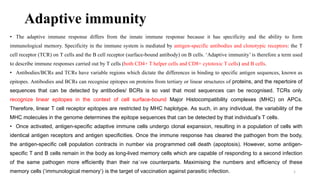The adaptive immune response has specificity and immunological memory. Antibodies and T cell receptors recognize specific epitopes on antigens. Activated T cells undergo clonal expansion. Memory T and B cells remain after infection to facilitate a faster response upon reinfection. The MHC presents antigen peptides to T cells in a haplotype-restricted manner. CD4+ T cells require three signals for activation: antigen recognition, co-stimulation, and cytokines. Effector CD4+ T cell subsets secrete distinct cytokines and provide different forms of immune help.































